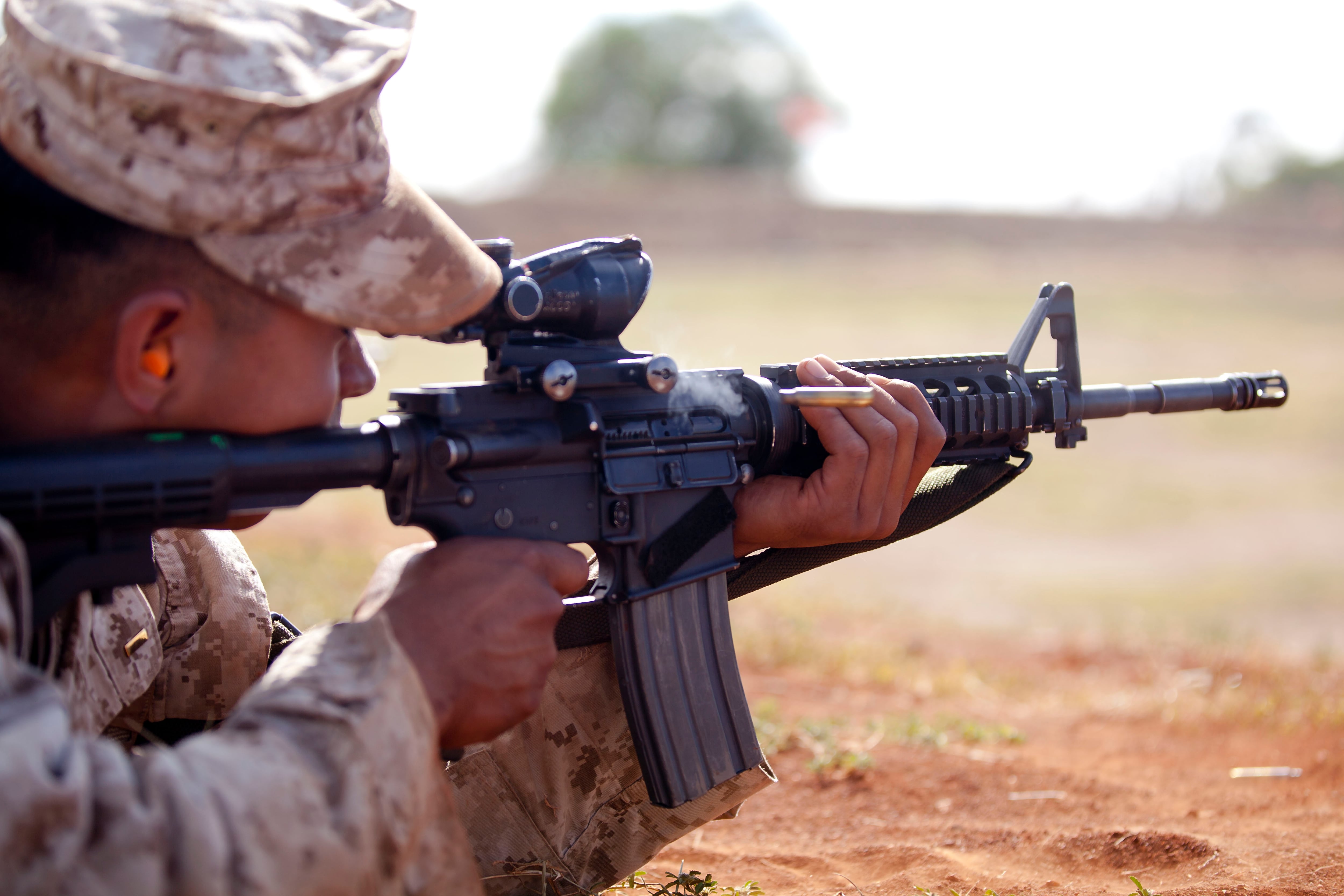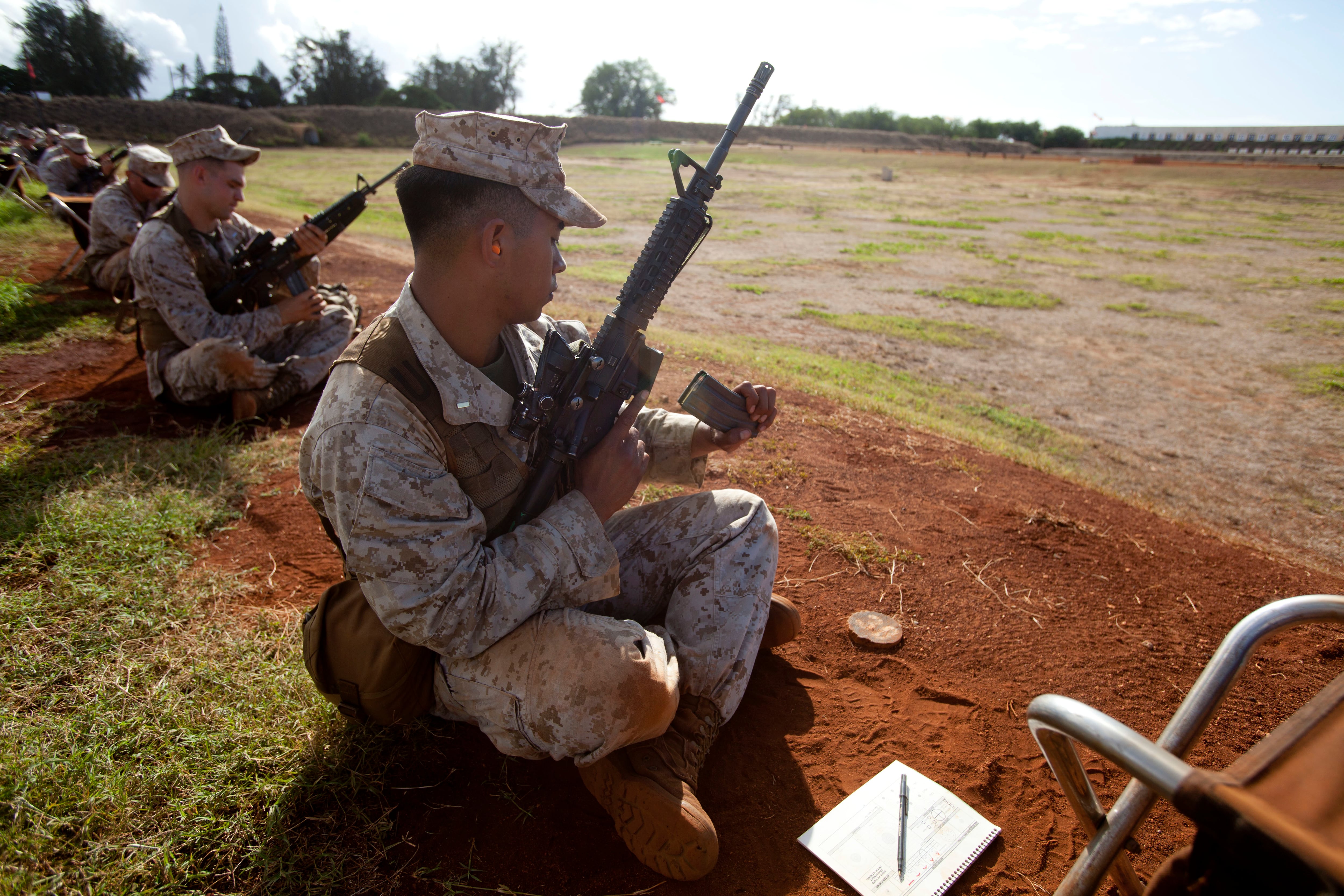Marines Shooters in Hawaii are using rubberized shooting mats on the rifle range, a comfort upgrade recently got a more comfortable surface on the firing line which base range officials credit with a dramatically reducing failures during annual marksmanship reduction in the number of Marines failing annual rifle qualifications and say could be usefull at other installations.
The Puuloa Range at Marine Corps Base Hawaii was particularly notorious for its unpleasant, uncomfortable, uneven surface, lack of grass and staining blood-red dirt that threw shots and stained Marines' ruined uniforms cammies by the hundreds. "Marines who trained there were training aboard Puuloa Range were at a "clear disadvantage," said Chief Warrant Officer 2 Jordan Kramp, the range officer in charge.
"The condition of firing lines prohibited their ability to acquire foundational shooting positions," Kramp said. "Hardened, overly matted-down surfaces prevented Marines from acquiring proper positions for firing, [resulting in] " because of "both firing and support elbows sliding out during specific stages of fire."
The new mats were, If trends hold, new rubberized mats which were unveiled in January and installed in January at the Puuloa Range's 200-, 300- and 500-yard firing lines. Early results suggest there could be about a 90 percent reduction in the number of Marines who fail their first qualification. are expected to yield could result in about a 90 percent reduction in the number of Marines who fail their first qualification, officials said. During the first three months after installation, just two Marines had to requalify from four training details, according to a Marine news release. A training detail is typically composed of between 250 and 275 Marines. That means by year's end, just 12-13 Marines may have to requalify compared to 127 in 2014.
One combat correspondent who shot off the mats said they were a significant advantage.
"They were so comfortable especially in the prone," said Cpl. Brittney Vella, a combat correspondent who is assigned to the base's Headquarters Battalion, Marine Corps Base Hawaii. "If you had rocks on your elbows it was difficult to have a stable base, so the mats helped us be stable and you felt like you connected with the ground a lot better."
Vella shot a 280, lower than the 295 she registered two years ago while attending boot camp at Marine Corps Recruit Depot Parris Island, South Carolina, the last time she had to qualify has only shot at Hawaii after the mats were installed early this year. The recruit depot has last time she qualified was about two years ago during bootcamp at Marine Corps Recruit Depot Parris Island where there is a combination of natural and artificial surfaces, she explained. But compared to Hawaii before the installation of mats, Vella added, those surfaces were much more even. And without the mats, she's convinced she would have performed worse. She actually shot better then – 295 compared to 280 – but the surfaces there are much more even. And without the mats, she's convinced she and she is confident should would have performed worse had a far lower score qualification in Hawaii without the mats.
She attributed her lower score in part to "psyching" herself out, but also a new and more challenging course of fire being rolled out across the service. As of this year, table 2 now emphasizes more combat-centric skills including shoot/no-shoot scenarios, photo-realistic targets, shot placement, and firing from long to short ranges as if closing with the enemy. Her group was the first to shoot the new course of fire which includes faster combat reloads that Marines are still getting used to, she said.
Several She added that she knows Marines who shot at Puuloa before and after the mats were installed improved markedly, Vella said. Some and went from failing to qualify to qualifying with a respectable score. A recent Marine news release about the mats highlighted the case of Pfc. Alexis Gooding, another member of the base's Marine Corps Base Hawaii's Headquarters Battalion. She failed her first rifle qual, scoring 86 out of 250. After the mats were installed, she shot expert because "I felt a lot more comfortable, and I could keep my hold."
Ultimately, Gooding because of the rubber material," she said. She ultimately scored a 325.
At first glance, the extra comfort mats and the comfort they provide may seem at odds with the service's Marine Corps' steady march toward growing the amount of introducing more combat marksmanship training Marines receive earlier in a Marines training and into more tables of fire. Officials want troops to train as they fight — and on the battlefield, it's Marines are likely Marines will be forced to have to shoot from uncomfortable or awkward positions while on the move.
In But, in fact, proficiency in combat marksmanship must be built upon several basic predicated on a solid foundation of marksmanship fundamentals, including to include sight alignment, sight picture and trigger control. Those skills can be hard to master hone when the shooter is distracted because he or she is uncomfortable challenged with distracting discomfort. "The mats allow Marines certainly help with the comfort for a shooter allowing them to focus better on shooting positions and other fundamental skills sets," said 1st Lt. Matt Rojo, a Weapons Training Battalion spokesman at Marine Corps Base Quantico, Virginia.
"Table one is the number one way that a Marine displays his or her accuracy, and does in fact focus on the fundamentals.," he added. "A Marine who has a solid foundation of the fundamentals first will better be able to apply those skills in adverse conditions," said 1st Lt. Matt Rojo, a spokesman for Weapons Training Battalion in Quantico, Virginia, where the service's foremost weapons experts continually study the science of marksmanship.

Marines train at Pu'uloa Rifle Range near in 2013, shooting off of uneven ground that hurt qualification scores and destroyed uniforms. The base range installed rubberized mats to fix the problem.
Photo Credit: Lance Cpl. Aaron Patterson/Marine Corps
The In addition to improving rifle qualification scores, the mats are saving Marines some money welcome relief for Marines' uniforms and their wallets. The range's hard, uneven volcanic red dirt stained Marines uniforms, particularly at the elbows and knees, said Cpl. Vella said. Now, she can wear the same cammies and boots she wears to work every day. After a single wash they looked office-appropriate again.
Kramp, for one, sees a potential benefit in rolling out the mats across the entire Marine Corps, saying that doing so could help "standardize training across the entire marksmanship spectrum, to include more comparable data collection and comparison amongst range sites that conduct like training."
Rojo said there are no plans to do so, as When asked if there are plans to introduce the rubberized shooting mats at other installations, across the Corps given the significant gains in marksmanship proficiency seen in Hawaii, WTB officials at Quantico responded that each facility range has a its own unique environment. "The solution, he said, "There is not a current effort to institute these particular mats across all known distance ranges," Rojo said. "Each range has its individual issues and the solution may not be the same on every range."
Indeed, some other ranges already have comfortable level grass, or a consistent artificial surface like concrete. But Kramp sees the potential benefit of rolling out the mats across the entire Corps saying it could help "standardize training across the entire marksmanship spectrum to include more comparable data collection and comparison amongst range sites that conduct like training. And as Kramp notes, these mats are not the only means to help improve scores. Commands see gains when they there's more to the improvement seen among shooters at Hawaii and across the Corps, however. Kramp said gains are also due to commands that allow for a solid "grass week," a little extra time for Marines to get reacquainted with ranges before they shoot for score. He also advocates for unit's to take advantage of indoor simulators, simulated marksmanship trainers which the service is currently overhauling to enhance add realism and better integration between multiple shooters. On-site combat marksmanship coaches and trainers also are beneficial, he said.
But at Hawaii, "the introduction of rubberized firing mats proved to be the single most effective modification that produced measurable results," he said.
Officials at Quantico or in Hawaii have not conducted a financial cost-savings analysis to determine if the shooting mats used in Hawaii, which cost $200,000 to install, have ultimately reduced overall range costs. But the need for fewer re-qualifications will reduce the amount of means less ammunition and range time Marines need, both of which are expensive.
Leaders at Quantico said after their last marksmanship symposium that they are pursuing initiatives to reduce unnecessary range time as a cost cutting measure. That includes efforts to improve and increase virtual marksmanship training with more realistic next-generation simulators so that when Marines arrive at the range, their fundamentals are already solid and need only be honed.
Another long-term possibility is providing Marines with digital log books so they have an exact record of their range time, allowing them to focus during subsequent range sessions on those skills needing the most improvement.
The new rubberized mats seem to complement those efforts.
At the very least, they are getting positive reviews from individual Marines and possibly helping to save careers. As in hyper-competitive re-enlistment has become more competitive in recent years, environment where marksmanship scores are closely scrutinized while deciding who is allowed to stay in the service and who goes among several other factors like Combat and Physical Fitness Test scores.

Marines' uniforms would take a beating at the Puuloa Rifle Range before rubberized mats were installed.
Photo Credit: Lance Cpl. Aaron Patterson/Marine Corps





